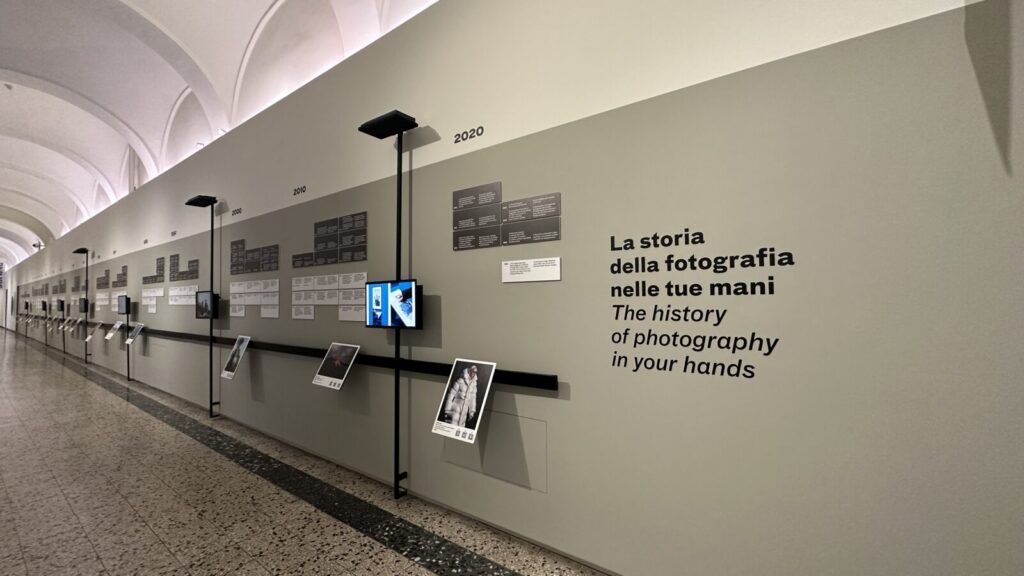
CAMERA has inaugurated in the Manica Lunga of its Turin headquarters a new permanent multimedia exhibition – The History of Photography in Your Hands – which traces the milestones in the history of photography.
This long timeline, made up of panels, digital content, videos and written texts, was born out of the desire to enable blind and visually impaired people to enjoy the fascinating history of photography. The story is told through a selection of images that represent the most important moments in this history, touching on the main genres and ways in which photography has developed over almost two centuries, from portraiture to reportage, from artistic photography to fashion photography, to images produced by Artificial Intelligence.
There are no photographs hung on the walls, as in a traditional exhibition, but rather visual-tactile panels produced using the sophisticated technique of adduction, which allows a faithful representation of the image but also the presence of a transparent resin relief on the main features of the subject. Presenting the image from a purely visual point of view and, at the same time, giving the blind and partially sighted the opportunity to explore it tactilely thanks to the resin reliefs, makes it possible to create undifferentiated proposals and to ensure a complete and homogeneous incisiveness of the message. Each panel is accompanied by Braille captions and detailed video descriptions in LIS (Italian Sign Language).
In order to tell the full story of photography, it is also necessary to place the image in a wider social and political context: for this reason, the itinerary also includes videos, which are interspersed with the images and can be enjoyed through screens equipped with a state-of-the-art amplification system that provides non-invasive punctual audio. The images and videos are installed through a system of tracks, so that the route can be progressively integrated with new content.
The multimedia exhibition is part of the Open CAMERA project, which aims to improve inclusivity by breaking down physical, cognitive and sensory barriers, and was funded by the National Recovery and Resilience Plan. Mission 1 – Digitization, Innovation, Culture and Tourism – Component 3 – Tourism and Culture 4.0 (M1C3), Measure 1 “Cultural Heritage for the Next Generation,” Investment 1.2 “Removing physical and cognitive barriers in museums, libraries and archives to enable wider access and participation in culture” funded by the European Union – NextGenerationEU.
In fact, in addition to the permanent exhibition, the project presents a significant renovation of the spaces and flows, aimed at eliminating architectural barriers and making CAMERA a relaxing space, capable of creating a dimension of psychophysical well-being, where everyone can modulate their visit experience according to their individual times and needs.
The main measure is a system of ramps leading from the outdoor walkway to the exhibition and other service areas. A new, more accessible reception structure will serve as a ticket office and, on the opposite level, as a shop selling books and merchandise; the bookshop, which is fully accessible, will be relocated to a brighter, more airy space. The visitor route is complemented by new seating and a quiet, intimate space at the end of the Manica Lunga, designed for reading, consulting digital content on a tablet, simply taking a break between exhibitions or even having a breastfeed. In order to increase the sense of well-being and improve the air quality, two green areas with special essences have been created.
As part of Open CAMERA, ETT was actively involved in defining the multimedia design and created a large part of the layout. The new flow distribution node features two backlit walls and a monitor providing up-to-date information on CAMERA’s activities. Meanwhile, The History of Photography in Your Hands consists of a multimedia experience developed on a static and a dynamic wall; the former consists of a track with a base for multisensory visual-tactile panels and a structure for the installation of monitors for audio-controlled devices; the dynamic wall, on the other hand, counts on the presence of two touch monitors designed to allow visitors to navigate through the Imaginarium, CAMERA’s digital platform for image education.
